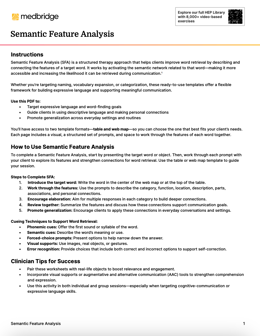Semantic Feature Analysis: How It Works and How to Use It in Therapy
Struggling with word retrieval can make communication frustrating. This guide breaks down how semantic feature analysis helps strengthen connections in the brain, improve word-finding, and support real-world communication. Plus, get a free downloadable PDF with structured templates to use in therapy!
April 23, 2025
10 min. read

Semantic feature analysis (SFA) is a well-studied language therapy technique that helps individuals with word retrieval difficulties by activating semantic connections in the brain. By exploring a word’s meaning—such as its category, function, and associations—SFA reinforces pathways for more efficient and effective word-finding.
Difficulty recalling words is a hallmark symptom of aphasia, a condition that affects approximately two million people in the U.S.1 Some experience occasional word-finding delays, while others struggle with severe communication disruptions. Hesitations, word substitutions, and circumlocution—describing a word instead of saying it—can make speech hard to follow. In more severe cases, sound errors or non-words (also called neologisms) further impact clarity, affecting relationships, work, and social interactions. By focusing on meaning-based word characteristics, semantic feature analysis provides a structured method for strengthening word retrieval and improving communication.
In this article, we’ll explore how semantic feature analysis works, the research behind it, and how to apply it in practice. You’ll also find a free downloadable Semantic Feature Analysis PDF, complete with structured templates to support your therapy sessions.
What is semantic feature analysis?
Semantic feature analysis is a structured treatment approach based on the idea that words are stored and organized in the brain according to their meanings or semantic features. These features include a word’s category, function, location, association, and more. By systematically activating multiple attributes of a word, semantic feature analysis strengthens connections within the semantic system, making retrieval more efficient.
For example, if a client is struggling to retrieve the word apple, they might be guided to describe it as a fruit (category), red or green (appearance), found in orchards (location), used for eating or making cider (function), and has seeds and a stem (parts). This process builds activation across a network of related words and concepts, improving not only the retrieval of trained words but also generalization to untrained items.
Research demonstrates that engaging multiple features increases the likelihood of successful word retrieval by stimulating broader semantic and lexical networks.1 This makes semantic feature analysis a valuable tool for individuals experiencing word-finding difficulties due to aphasia, cognitive-communication impairments, or other language disorders.
Evidence-based benefits of semantic feature analysis
Research has consistently demonstrated that semantic feature analysis is an effective intervention for individuals with word-finding difficulties. Some of the key findings include:
Improved naming accuracy: Clients improve retrieval of both trained and untrained words due to SFA’s emphasis on activating semantic networks.2,3
Stronger generalization effects: Studies indicate that SFA can promote generalization to untrained words, particularly when a broad range of semantic categories is targeted.2
Enhanced discourse and communication: Beyond improving single-word retrieval, SFA is associated with increased sentence completeness, coherence, and efficiency, leading to more natural, meaningful conversations.4
Neuroplasticity and brain activation: fMRI studies indicate that semantic feature analysis can stimulate neural reorganization, recruiting brain areas associated with language processing and supporting long-term recovery in individuals with aphasia.5
How to use semantic feature analysis
Introduce the semantic feature analysis template.
Present a picture of the target word.
Guide the client through the semantic features.
Attempt word retrieval again.
Reinforce and encourage independent use.
Semantic feature analysis is most effective when implemented systematically, reinforcing semantic connections while promoting independent word retrieval.
To help you streamline this process, we’ve created a free, downloadable Semantic Feature Analysis PDF that includes ready-to-use templates for guiding clients through this technique. With both table and web map formats, this resource makes it easy to personalize therapy sessions while reinforcing meaningful communication.
Semantic Feature Analysis PDF
Fill out the form to unlock your free PDF!

Below is a step-by-step guide to incorporating the Semantic Feature Analysis PDF in your sessions.
Step 1: Introduce the semantic feature analysis template
Start by presenting the semantic feature analysis template, which provides a structured way for clients to analyze and describe a word’s characteristics. The template helps activate semantic connections, reinforcing word retrieval and expressive language.
Step 2: Present a picture of the target word
Select a picture stimulus or real-life object that aligns with the client’s communication goals. Ask them to name the item.
If they retrieve the word correctly, reinforce their response, and continue with feature analysis to strengthen semantic connections.
If they struggle to retrieve the word, guide them through the template before providing the correct word.
Step 3: Guide the client through the semantic features
Prompt the client to describe the target word using the features outlined in the semantic feature analysis template. If they have difficulty generating responses, use additional cues such as:
Binary choice: “Is it round or square?”
Forced association: “Does it remind you of something sweet or savory?”
Phonemic cueing: “It starts with ‘buh…’”
Sentence cueing: “The grass is…”
You can also engage multiple modalities by having clients say, write, type, or point to features. This multi-sensory approach reinforces learning and supports different communication strengths.
Step 4: Attempt word retrieval again
Prompt the client to name the word after completing the template:
If they retrieve the word, reinforce their success and discuss how the strategy helped.
If they still struggle, provide a model of the correct word, review the features aloud, and encourage self-cueing for future attempts.
Step 5: Reinforce and encourage independent use
Gradually decrease your support as therapy progresses to help clients apply semantic feature analysis strategies on their own. Encourage your client to:
Use a small SFA cue card with feature prompts for self-cueing in daily conversations.
Apply the strategy in real-life settings, such as describing objects at home or discussing favorite activities.
Repeat the process with different words to build stronger generalization skills.
Clinical tip: Clients benefit from consistent order and repetition in feature generation. Going through the categories in the same sequence each time builds procedural memory, reinforcing automatic word-retrieval strategies.
Key factors for generalization and success
Not all semantic feature analysis sessions will yield the same results. Some clients may see immediate improvements, while others may need more structured support to make progress. The key to maximizing treatment effectiveness and ensuring that gains extend beyond therapy is how you implement SFA in ways that promote real-world application and long-term retention.
Here are some strategies to help you optimize treatment and support generalization:
Expand the semantic network
Sticking to just a few categories won’t cut it. The more semantic connections you activate, the better the generalization. Introduce various word types and encourage clients to explore multiple attributes of each word to strengthen broader neural networks.
Clinical tip: Instead of repeatedly practicing common nouns like “dog” or “apple,” introduce a mix of categories—such as actions (running, chopping), abstract concepts (freedom, kindness), and less frequently used but personally meaningful words (gardening tools, musical instruments).
Make it meaningful
Words that are concrete and personally relevant stick better. Clients will have more success retrieving words that connect to their daily routines. Prioritize words they use in real-life settings, making therapy more functional and engaging.
Clinical tip: If a client enjoys cooking, focus on words related to ingredients, kitchen tools, and common recipes they frequently discuss at home. This makes it more likely they will apply semantic feature analysis strategies in everyday conversations, improving carryover and confidence.
Strengthen the connections
Don't stop at one or two features. Encourage clients to generate at least five or six semantic details for each word. The more features they activate, the stronger the neural connections, leading to more efficient retrieval.
Clinical tip: If the target word is "hammer," prompt clients to describe its category (tool), function (used for building), appearance (has a handle and metal head), location (found in a toolbox), and associated items (nails, wood). Expanding the feature set strengthens word retrieval across related concepts, making retrieval more automatic.
Step back to build independence
The ultimate goal is for clients to use semantic feature analysis strategies on their own. Gradually fade cues and prompts to help them develop self-cueing skills. Providing too much support for too long can limit their ability to apply SFA outside of therapy.
Clinical tip: Start with full verbal cues ("What category is it? What does it look like?"), then transition to visual SFA templates with minimal prompts and eventually encourage self-cueing, where the client independently retrieves words by thinking through features on their own. Encouraging self-monitoring (like asking, "How did I figure that out?") also strengthens metacognitive skills.
Bridge the gap to real-world use
Therapy doesn’t end when the session is over. Help clients integrate semantic feature analysis into their daily routines with self-cueing strategies, take-home practice, or structured conversation prompts. Encouraging them to use their new skills in real-world settings improves carryover and confidence.
Clinical tip: If a client struggles with word retrieval during conversations, a take-home cue card listing SFA feature prompts (e.g., "Think about what it looks like," "What is it used for?") can help them recall words in real time while talking with family or coworkers.
Train the team
Clients don’t communicate in isolation—so why should therapy happen that way? Frequent communication partners (spouses, children, close friends, caregivers) can be powerful allies in strengthening semantic networks outside the clinic. When trained to offer strategic cues—not answers—they can help reinforce the use of SFA strategies in natural contexts. This creates more opportunities for successful word retrieval and promotes generalization in everyday conversation.
Clinical tip: Educate communication partners on how to give simple, structured prompts based on the SFA approach. Instead of saying, “You mean a hammer?” try “What do you use it for?” or “Where would you find it?” Teach them to be patient, give time for processing, and celebrate partial success. A short handout or a mini-session with the partner can go a long way in helping them understand how to support—not rescue—the client during a word-finding moment.
Applying semantic feature analysis beyond the therapy room
Semantic feature analysis is more than just a structured word-retrieval exercise—it’s a research-backed approach that helps clients regain confidence in communication. By strengthening semantic networks, SFA enhances word-finding abilities and supports real-world language use, making it a valuable tool for speech-language pathologists working with individuals who experience aphasia or other language impairments.
With the right implementation strategies, including expanding semantic connections, personalizing word selection, reinforcing deep processing, and promoting self-cueing, clinicians can maximize the effectiveness of semantic feature analysis and encourage long-term generalization. The true impact of SFA happens beyond the therapy room, when clients integrate these strategies into their daily conversations, improving their ability to communicate independently.
Speech language pathology continuing education is essential for refining your skills, staying up to date with best practices, and applying the latest evidence-based strategies in therapy. Expanding your expertise in language interventions, cognitive rehabilitation, and other treatment techniques can help you make a greater impact—both in structured sessions and everyday communication settings.
References
Below, watch Mary Boyle discuss semantic features in this brief clip from her Medbridge course "Semantic Feature Analysis Treatment for Individuals with Aphasia."






